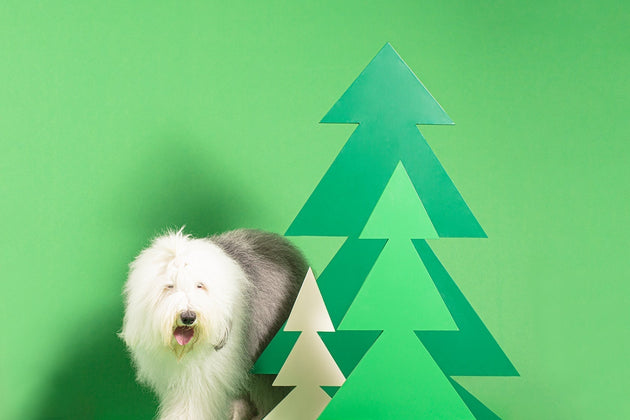
FREE UK DELIVERY ON ORDERS OVER £39.99
Owners of long-haired breeds will be the first to admit that, despite being absolutely beautiful, their dog's coat can sometimes be somewhat of a nuisance, especially in the spring and summer months!
Not only is it moulting season, but their fur can pick up all kinds of seeds and garden bits and pieces that are not only hard to remove, but can lead to other more serious issues. This is particularly the case for fox tail grass seeds.
If you’re not aware of the dangers of fox tail grass seeds, read on to learn about what they are, why exactly they are a danger, what to do if your dog is suffering and what you can do to prevent them from being affected.
Grass seeds are small, pointy seeds at the top of long grass stems, and are typically found in fields and hedgerows, but have been known to grow on the side of the road in more suburban areas. There are many species of grass seeds, but one that seem to cause dogs the most trouble are fox tail grass seeds.
These seeds are barbed, often spiky, and shaped in such a way that they can cling onto the fur of animals (this is how they travel) and easily fit into small spaces, but prove much harder to get out. In the spring and summer, these seeds are abundant and can easily be picked up by your dog as they explore on walks.
Due to the barbed, shuttlecock shape of grass seeds, they can easily cling to your dog's coat or, in worst-case scenarios, can burrow into your dog’s skin, ears, nose, eyes and paws - getting deep into the tissue and causing discomfort or even an infection.
Grass seeds cause particular risks around your dog’s paws, as their pads are sensitive and can be easily injured. This also can be said for their ears, as seeds can get inside your pooch’s ear canal and cause an unseen blockage.
Since grass seeds can easily hide anywhere on your dog, it can be hard to detect when one has become stuck or lodged. That said, it's important to recognise the common symptoms of a lodged grass seed so you can investigate further and get your pooch the right treatment. Here are things to look out for when it comes to grass seed, especially after going out for a walk:

If you manage to see a grass seed on your dog or catch it before it comes embedded, you should remove it. If it has become embedded or you are unable to see it anymore, be sure to contact your vet.
If your dog is showing aforementioned symptoms or signs of discomfort and you can’t seem to target the grass seed culprit (perhaps because it’s hidden, burrowed or deep in your dog’s ear), it's time to call the vet. Grass seeds can go undetected by owners, and won’t come out on their own, so avoid serious infections by getting a vet to help you.
As grass seeds don’t show up on an x-ray, your pooch will need a proper examination with your vet’s eyesight and tools. They will do a hands-on inspection to locate the grass seed, usually focusing on paws, eyelids, ears, chest and armpits.
Sometimes, they might use an otoscope to look deep into the ears, or even try an ultrasound if they suspect a seed has migrated under the skin. If the seed is embedded and not removed easily, your dog might need anaesthesia or even minor surgery to remove it.
Grass seeds can be dangerous for dogs if they become lodged in their skin, ears, eyes or paws. If not removed, your pooch can get infections or even internal injuries if they travel into the body.
In rare cases, infections from grass seed can lead to life-threatening conditions, so check your dog regularly and remove any seeds or call a vet as soon as you suspect them.

We can't always have eyes on our dog, and due to how small grass seeds are, they can be missed. However, there are some things you can do to help prevent your dog from picking up grass seeds on a walk. That said, if walking in an area where grass seeds are prevalent, always check over your dog to make sure they haven't picked up any grass seeds.
Any dogs with medium to long coats are more prone to picking up grass seeds, but really, they can cling to any dog.
Breeds with long coats are prone to picking up grass seeds in their coats, while active or excitable dogs may be more likely to run out into long grasses or hedgerows. These can include:
This is very serious - so call your vet straight away. If you’ve noticed your dog shaking their head, coughing, sneezing or acting strangely, a grass seed might be stuck in their nasal passages and will need removing immediately.
If your dog only has a few grass seeds stuck in their coat they might fall out on their own. But you should always check your dog over and remove them yourself, as seeds can travel around a dog’s body and cause harm. If a grass seed is stuck in the skin, it’s unlikely this will come out on its own. Be thorough in examining your pooch, and remove loose grass seeds when you find them. If you find they're lodged or your dog is experiencing too much discomfort, definitely call a vet.
Those little green or brown balls stuck in your dog’s coat are likely burrs, or seed pods from plants such as goosegrass. They might look harmless, but they can irritate the skin and matt fur. Unlike grass seeds, they don’t typically burrow under the skin but it’s still a good idea to remove them for your pooch’s comfort.
Look for sudden changes in your pooch’s behaviour after a walk or outdoors time, such as limping, licking a paw, shaking their head, or even squinting. You might also spot a small, red bump or wound on their skin. Give your dog a once-over, checking between toes, in their ears, under armpits and around the eyes. If anything looks inflamed or painful, or your dog is acting out of sorts, it’s time for a vet check.
To keep your pooch happy and focused with something natural and healthy, Pooch & Mutt’s grain-free dog treats include delicious, functional flavours such as turkey, hemp and peanut butter, as well as powerful probiotics that promote a harmonious gut.





Never miss a treat!
Subscribe to our newsletter and get blog articles amongst other treats delivered to your inbox




Comments (0)
Leave a comment